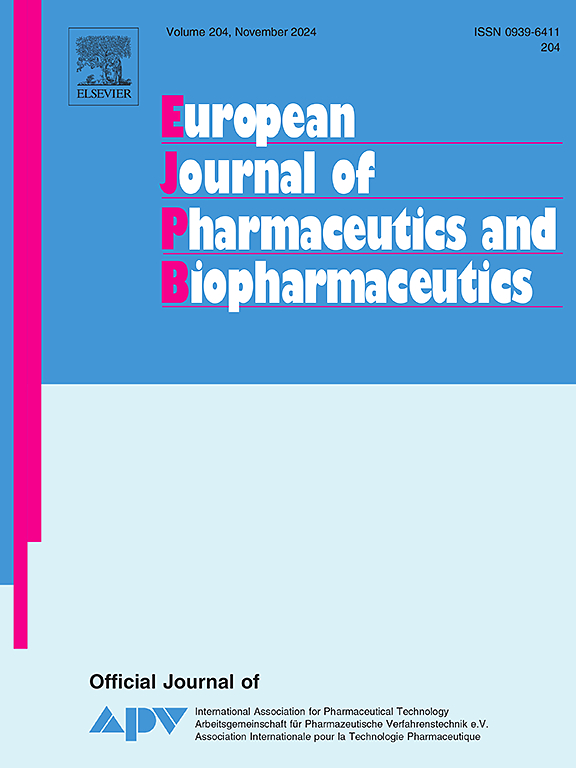基于溶质-溶剂界面张力的固体药物在纯溶剂中的溶解度新模型。
IF 4.4
2区 医学
Q1 PHARMACOLOGY & PHARMACY
European Journal of Pharmaceutics and Biopharmaceutics
Pub Date : 2025-01-31
DOI:10.1016/j.ejpb.2025.114653
引用次数: 0
摘要
药物在生物体液中的溶解度与药代动力学特性(吸收、生物转化和排泄)、功效和毒性有关。揭示药物溶解行为背后的内在原因是一项令人着迷且具有挑战性的任务。经典热力学方法通过固液平衡(SLE)方程加活度系数模型(UNIFAC、cosmoo - rs、cosmoo - sac等)估计药物在液体溶剂中的溶解度,其中溶质分子在溶液中的摩尔溶解能(偏摩尔过量吉布斯能)通过活度系数模型计算。新方法通过溶质分子的自由转移能(从固相到液相)来预测溶质的溶解度,根据溶质-溶剂(液-液)界面张力,其中溶质分子的摩尔溶解能由溶质-溶剂界面张力决定。溶质-溶剂(液-液)界面张力由cosmos - uce(通用黏结能估计类导体筛选模型)的黏结能计算结果得到。该模型在固体药物在纯液体溶剂中的溶解度预测中的应用已经得到了广泛的验证,并取得了成功的结果。该模型溶解度表征性能与SLE + UNIFAC相似,溶解度预测结果明显优于SLE + cosmos - sac。本文章由计算机程序翻译,如有差异,请以英文原文为准。

New solubility model for solid drugs in pure solvents based on solute-solvent interfacial tension
The solubility of drugs in biological fluids is associated with pharmacokinetic properties (absorption, biotransformation and excretion), efficacy and toxicity. It is a fascinating and challenging task to uncover the intrinsic reason underlying the dissolution behavior of pharmaceuticals. The classical thermodynamic method estimates the drug solubility in liquid solvent via Solid-Liquid Equilibrium (SLE) equation plus activity coefficient models (UNIFAC, COSMO-RS, COSMO-SAC, etc), where the molar dissolution energy (partial molar excess Gibbs energy) of solute molecules in solution is calculated through activity coefficient models. The new method predicts the solute solubility via the transfer free energy (from solid phase to liquid phase) of solute molecules in terms of fusion properties and solute–solvent (liquid–liquid) interfacial tension, where the molar dissolution energy of solute molecules is determined by solute–solvent interfacial tension, and the solute–solvent (liquid–liquid) interfacial tension is obtained from the cohesive energy calculation results of COSMO-UCE (Conductor-Like Screening Model for Universal Cohesive Energy estimation) based merely on the molecular structure. The application of this model in solubility prediction of solid drugs in pure liquid solvents has been verified extensively with successful results. This model yields similar solute solubility representation performance as that of SLE + UNIFAC, and obtains much better solubility prediction results than SLE + COSMO-SAC.
求助全文
通过发布文献求助,成功后即可免费获取论文全文。
去求助
来源期刊
CiteScore
8.80
自引率
4.10%
发文量
211
审稿时长
36 days
期刊介绍:
The European Journal of Pharmaceutics and Biopharmaceutics provides a medium for the publication of novel, innovative and hypothesis-driven research from the areas of Pharmaceutics and Biopharmaceutics.
Topics covered include for example:
Design and development of drug delivery systems for pharmaceuticals and biopharmaceuticals (small molecules, proteins, nucleic acids)
Aspects of manufacturing process design
Biomedical aspects of drug product design
Strategies and formulations for controlled drug transport across biological barriers
Physicochemical aspects of drug product development
Novel excipients for drug product design
Drug delivery and controlled release systems for systemic and local applications
Nanomaterials for therapeutic and diagnostic purposes
Advanced therapy medicinal products
Medical devices supporting a distinct pharmacological effect.

 求助内容:
求助内容: 应助结果提醒方式:
应助结果提醒方式:


